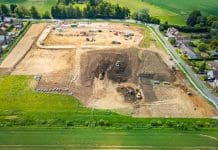Angela Cornell, of Fisher German outlines the role of the planner and the challenges faced in bringing a site to the development stage…
The UK today is an ever-changing landscape, quite literally. New developments are springing up every day, in both rural and urban areas, including large housing estates, land conversions or small plots. At the start of building new developments, it may seem like the beginning of the process but in reality, months of hard work have already taken place before any foundations are laid.
Angela Cornell, from Fisher German, is just one planner who is working every day to ensure new developments are built. In this feature she explains her role and what it takes to make it in the profession…
What does a planner actually do?
Whether in a rural or urban location, the planner is there to make development proposals a reality. Building developers, who are seeking to build a new housing estate for example, will first have to put a planning application forward to the local planning authority (LPA) for approval. A planner, who works for the developer, is there to ensure the application is successful.
A planner like Angela, must address a number of constraints before submitting the application.
“As a planner, we are there to coordinate the planning process. We have to look all the constraints on a site, conduct surveys and ensure we have addressed all the problems that could effect a planning application for our client. We are very much the middle man between our client (the developer) and the LPA and council,” she says.
Initial development plans might have to change due to constraints and it’s up to the planners to strike a happy balance between the initial proposal and what’s realistically achievable. Planners take full responsibility for the proposal and work to ensure that both the client and the LPA are happy.
Everyday factors to consider
When a developer identifies a site they wish to build upon or convert, it’s over to the planner to tackle problems and make the development happen. Angela explains: “When we initially visit a site, very often it’s obvious that the development proposal will have to be altered due to a number of factors on the site.”
Constraints on a site can include:
- Protected/listing buildings already on the land
- Drainage and flood risk
- Contamination
- Ecology
- Highways and transportation
The role of the planner now is to act as the project manager. They will coordinate surveyors who will assess the application and the land and make recommendations on the issues identified. However, one of the more difficult limitations to tackle may seem like the most trivial, as Angela says: “It’s the landscape and visual impact of a development that is the most challenging with every project because it’s so subjective. While the developers and I might look at a plan and not see anything wrong, the LMA or members of the public might think planned buildings stand out too much or ruin the landscape.”
It’s here where planners must use their negotiation skills.
Challenges and the art of negotiation
A planner has to use their negotiation skills every working day and in various situations. Once all the initial surveying of a site is complete, the initial development plan still may have to change due to issues arising from the surveyors.
“In some cases the development site will need to be cut short, extended or the plan altered in some way. We have to take constraints into consideration and advise our clients on what they can achieve. Any changes due to listed building, heritage sites and protected land for example will be fed into the final plan and design we submit,” explains Angela.
Once the development plans are finalised with the client, it’s up to the planner to put all the painstaking work together into one report and submit their final planning application to the LPA and council.
Planners take responsibility for the development application from start to finish. However even after the application is submitted, the planner still may have a part to play says Angela: “In some cases the LPA may reject the application due to one or two factors, or just completely reject it out of hand. The developer then has the option to appeal, which we again have to manage.”
The planner is involved in every aspect of the application from start to finish. Planners like Angela are there to coordinate the whole process, negotiate with key stakeholders and keep their client happy.
Key skills of a successful planner
So what sort of skills do Angela and planners like her need to utilise every day?
- Impeccable negotiation skills
- Tenacity and taking rejection as a challenge
- Clear communication
- Strategic thinking
- Organisational skills
“Being a planner is very varied. It’s all about negotiation, patience and organisation. We play the middle man between the developer and the LPA. I think the main challenge of my role is keeping the client happy throughout the whole process,” she concludes.
Angela Cornell is an Associate Partner from Fisher German, a leading national firm of chartered surveyors and specialist property consultants.
Angela Cornell
Associate Partner
Fisher German
www.fishergerman.co.uk/planning-and-construction



![[VIDEO]Government launches new online appeal service for local planning authorities Group of young coworkers using computers in their group office, representing the new online appeals service](https://www.pbctoday.co.uk/news/wp-content/uploads/2025/12/iStock-2191280160-218x150.jpg)









